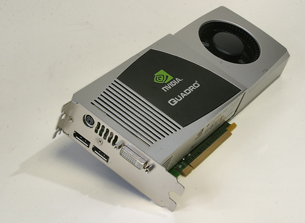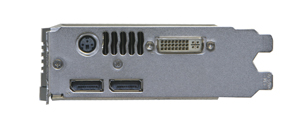More Power, Lower Price: NVIDIA Quadro FX 4800
We test NVIDIA's newest, most affordable ultra high-end graphics board.
December 4, 2001
By David Cohn
 Figure 1: The new NVIDIA Quadro FX 4800, a bit larger than its predecessor, has 1.5GB of video memory. (photo by David Cohn) |
Proving its continued ability to outpace Moore’s Law, NVIDIA sent us its latest ultra high-end graphics accelerator, the Quadro FX 4800. The new board—with twice the memory of its predecessor, the NVIDIA Quadro FX 4600 (see June 2007 DE)—is based on a second generation GT200 GPU with 192 CUDA parallel computing cores and delivers as much as a 2X performance increase over the previous generation graphics card.
The new NVIDIA Quadro FX 4800, which plugs into a PCI Express X16 graphics slot, is slightly larger than the FX 4600, measuring 4.36 in. x 10.5 in. At 150 watts, it also consumes a bit more power. That means that it requires an auxiliary connection to the system power supply. A large cooling fan and plastic cowl protrude more than an inch from the board, making it impossible to use the adjacent expansion slot.
On the output side, the new Quadro FX 4800 also departs from the past, providing just a single dual-link DVI-I connector. But it includes two of the new DisplayPort (DP) connectors. This new standard, first approved by VESA (the Video Electronics Standards Association) in 2006, is meant to replace both DVI and analog VGA. The USB-sized DP connector secures without thumbscrews, making it well suited for mobile and handheld devices. While not compatible with HDMI or DVI, it does support pass through of those signals.
Apple was first to market with DisplayPorts on its newest MacBooks, released in October. But this is the first DP-equipped graphics board we’ve seen. DP combines audio, video, and control data into packets (similar to data networks) and will enable thinner, smaller-form-factor monitors because signals can go directly from the PC to the monitor in a direct-drive configuration that can reduce monitor costs 20 percent or more by eliminating internal signal conversion circuitry.
DP also has the ability to include a new form of copy protection called DPCP (DisplayPort Content Protection) and the latest version of the DP spec (v1.1) also supports HDMI’s content protection (called HDCP) and the use of fiber optic cables for transmission of signals over very large distances without deterioration of data. And unlike HDMI, manufacturers implementing DP pay no licensing fees.
The Quadro FX 4800 board’s dual 10-bit DisplayPorts can deliver a color palette of more than a billion colors and support panel up to 2560 x 1600. Of course, in order to take full advantage of DisplayPort, you’ll need a DP-equipped monitor as well. Otherwise, you can use an adapter to connect to an older monitor or use the FX 4800’s single DVI-I connector. The board’s internal 400MHz DACs support one or two analog displays at resolutions up to 2048 x 1536 at 85Hz and the FX 4800 supports digital displays at resolutions up to 2560 x 1600 at 60Hz or as high as 3840 x 2400 at 24/41Hz refresh rates. The FX 4800 also provides a VESA stereo connector and supports NVIDIA’s G-SYN and SDI daughter cards, providing frame lock and broadcast-quality video capabilities, respectively.
 Figure 2: The Quadro FX 4800 provides only one DVI-I port and a stereo 3D port, but offers two of the new DisplayPort connectors. (photo by David Cohn) |
Like other high- and ultra high-end NVIDIA boards, the FX 4800 supports SLI frame rendering, which lets users combine two identical NVIDIA PCI Express graphics cards with an SLI connector to transparently scale application performance on a single display by presenting them as a single graphics card to the operating system.
The NVIDIA Quadro FX 4800 has a 384-bit memory interface, the same as the FX 4600, but increases the memory bandwidth to 76.8 GB/second. Equipped with 1.5GB of GDDR3 memory, the Quadro FX 4800 has the capacity to process large textures and frames in real time while providing fill rates of 38 billion texels per second and geometry performance of 300 million triangles per second. The board also features a 128-bit memory interface to maintain high accuracy and 12-bits sub-pixel precision.
The new Quadro FX 4800 also supports the latest OpenGL 3.0 specification as well as DirectX 10.0 and Shader Model 4.0, enabling complete hardware acceleration of even the very latest professional 3D graphics software.
Benchmarks Confirmed
NVIDIA has performed its own benchmark tests, which are published on the company’s website. To see the power of the new graphics accelerator for ourselves, we ran our own benchmarks. We installed the Quadro FX 4800 in the same HP xw6600 workstation we used in our wrap-up of last year’s NVIDIA graphics boards (see July 2008 DE), so all of our results are directly comparable. That system, equipped with a pair of 3.0GHz Quad-Core Xeon E5450 processors, was a close match to the computer NVIDIA used in its benchmarks.
Our SPEC Viewperf numbers confirm those from NVIDIA, showing that the FX 4800 outperformed the FX 4600, the company’s previous generation graphics accelerator in the same product range, and equaled the performance of the previous generation board in the next higher product range, the FX 5600, which itself was recently superseded by the NVIDIA Quadro FX 5800.
Like other workstation-class graphics accelerators from NVIDIA, the new Quadro FX 4800 is fully certified with most CAD and DCC applications and uses NVIDIA’s unified driver architecture (UDA). Drivers are available for Windows Vista and Windows XP (both 32- and 64-bit), Windows 2000 (32-bit only), Linux 32 and 64, Solaris, and FreeBSD x86.
While a board like the NVIDIA Quadro FX 4800 is likely overkill for midrange CAD users, those looking for the ultimate graphics power for design visualization will love it. And they’ll love the price even more. The Quadro FX 4800 is sold by selected resellers and VARs such as PNY. While NVIDIA released the board with a suggested retail price of $1,999, it has been selling for an average street price of $1,620. With the release of the NVIDIA Quadro FX 4800, never has ultra high-end graphics power been this affordable.
More Info:
Company Information
NVIDIA Corporation
Santa Clara, CA
Requirements:
PCI Express-based workstation with available x16 lane graphics slot; Microsoft Windows Vista (64-bit or 32-bit), Microsoft Windows XP (64-bit or 32-bit), Windows 2000 (32-bit), Linux (64-bit or 32-bit), Solaris, or FreeBSD x86.
Contributing Editor David Cohn is a computer consultant and technical writer based in Bellingham, WA, and has been benchmarking PCs since 1984. He’s the former editor-in-chief of Engineering Automation Report and CADCAMNet, and the author of more than a dozen books. Please send comments about this article to [email protected]. You can also contact David at [email protected].
Subscribe to our FREE magazine, FREE email newsletters or both!
About the Author
David Cohn is a consultant and technical writer based in Bellingham, WA, and has been benchmarking PCs since 1984. He is a Contributing Editor to Digital Engineering, the former senior content manager at 4D Technologies, and the author of more than a dozen books. Email at [email protected] or visit his website at www.dscohn.com.
Follow DE




